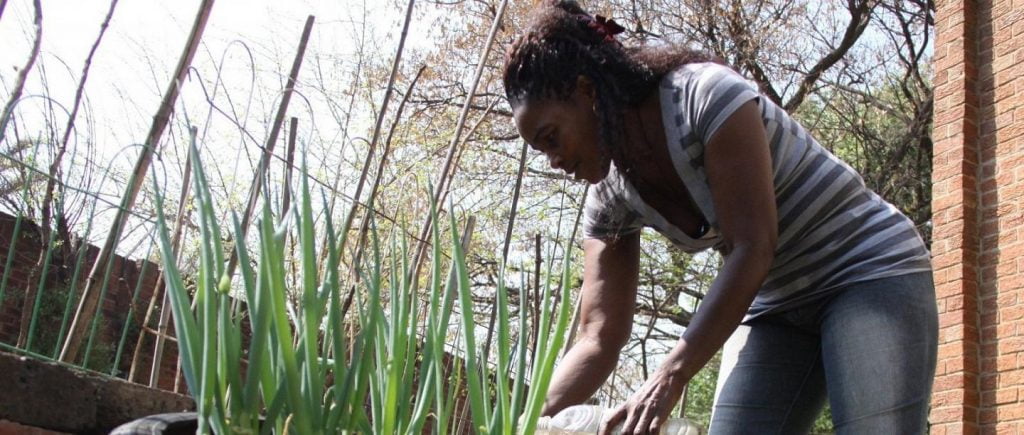

66-year-old Orah Bessit tends to vegetables in a garden at her home in Johannesburg. Bessit exercises regularly and switched from white bread to whole-grain. A growing urban middle class is defying the image of Africa as poor by fighting or avoiding obesity, diabetes, lung cancer, strokes and heart disease. But the urban poor are increasingly falling victim.
Non-communicable diseases (NCDs) — especially diabetes and cardiovascular disease — are often associated with the lifestyle of the developed world, but by 2030 they may kill more people in Africa than communicable diseases such as HIV/AIDS.
In the western imagination, Africa has always been a dangerous place because of malaria, yellow fever and, more recently, AIDS and Ebola. But today it is suffering both from a high incidence of communicable diseases, and from a rise in NCDs that places a strain on healthcare systems and on families, who are the main providers of healthcare.
The rapid growth of NCDs, too often overlooked, can only be addressed through grassroots health education and political engagement at national level. Diabetes is a typical example. “Diabetes has always existed in Africa,” says Saïd Norou Diop, an expert on the disease, “but in Senegal we have seen explosive growth over the past decade”.
NCDs killed more than 38 million people worldwide in 2012, 29 million of them in low- and middle-income countries such as Senegal, Cameroon, Congo-Brazzaville and Gabon. Their emergence is linked to a change in lifestyles, accelerated by rapid urbanisation.
At independence, only 15 per cent of the population of African countries lived in cities; today the figure has risen to nearly 38 per cent. This has led to changes in diet (more meat, oil, salt and sugary drinks), more sedentary lifestyles, greater consumption of alcohol and tobacco, and more exposure to chemicals.
The growth of diabetes is often blamed on the inadequacy or even absence of prevention programmes and the genetic predisposition of some populations, but these arguments should not distract from the overwhelming responsibility borne by agro-industry, which floods African markets with cheap, low-quality products.
The replacement of sumbala (a condiment made from néré seeds) with Maggi stock cubes (heavily marketed) is a typical case. Only governments are in a position to regulate the distribution of goods and disseminate the information that people need in order to look after their own health.
Malnutrition and obesity coexist
In 2014 diabetes is estimated to have cost US$612 billion in healthcare spending. More generally, the World Health Organisation (WHO) is concerned at the growth of ‘cumulative economic losses’ due to NCDs: the burden on health systems, the deterioration of the workforce due to illness and absenteeism, and the weakening of the social fabric. It estimates these losses at US$7000 billion between 2011 and 2025, whereas the cost of reducing the global burden of NCDs would be only US$11.2 billion a year.
Amongst NCDs, most deaths (around 80 per cent) are due to cardiovascular disease (17.3 million a year), followed by cancer (7.6 million), respiratory diseases (4.2 million) and diabetes (1.3 million).
In the poorest African countries, it is estimated that 75.1 per cent of those suffering from diabetes mellitus are undiagnosed.
In low- and middle-income countries such as Gabon, South Africa and Kenya, the entirely justified efforts to combat communicable diseases such as HIV/AIDS, tuberculosis and malaria have prevented earlier recognition of the growth of NCDs.
Amongst the risk factors for NCDs, poor diet is of particular concern because of its impact on the development of children. Being overweight predisposes to cardiovascular disease and diabetes. Children in low- and middle-income countries are especially vulnerable, suffering from insufficient nutrition during their prenatal period and infant and juvenile years, then from a poor diet, often high in fat, sugar and salt, with low nutritional value. Consequently, malnutrition can be seen alongside obesity.
The WHO emphasised these changes as early as 1991, but failed to elicit an appropriate reaction from public authorities. In 2002 it repeated its call for greater efforts to be made, and once more underlined the health consequences of dietary change. At the time, the deep inequalities between North and South, but also between the elites who sought treatment in the clinics of Morocco and Europe and the general population who had no access to healthcare, were already recognised.
Funding diverted
However, the emergence of HIV/AIDS in the late 1980s and the launch of large-scale initiatives to combat that disease, including the Joint UN Programme on HIV and AIDS (UNAIDS) in 1996, delayed investment in fighting diabetes and other NCDs for 25 years. Vertical programmes — which concentrate funding and medical personnel on combating a single disease — devoted to HIV have raised hopes that the disease may be eradicated, but have detrimentally affected the funding of the struggle against other diseases.
The identification of priority diseases, justified in the case of AIDS by the global risk it represented, is also a legacy of colonial health services, which often focused on a single disease (such as sleeping sickness).
The fight against NCDs is once again on the agenda, thanks notably to the WHO, but the concurrent rise of Ebola and Zika epidemics threatens to overshadow it. The funding of global health initiatives by the rich countries of the North is motivated more by the perceived risk to themselves than by any humanitarian impulse based on analysis of epidemiological data. If malaria, diabetes or maternal mortality were contagious, the face of global health would no doubt be very different.
Type 2 diabetes, the most common form in Africa, is a progressive illness that can require treatment with insulin. The healthcare systems of the least developed countries lack diagnostic and monitoring tools (such as means of measuring glycated hemoglobin levels to warn of complications) and means of treating diabetes other than amputation in severe cases. Prevention and patient education programmes are inadequate, and the poorest lack the financial means to follow suitable diets.
Mobile assist
The government of Senegal supports the m-Diabetes initiative set up by the WHO and the International Telecommunications Union, which uses mobile telephone networks (83 per cent of Senegalese have a mobile phone) to disseminate information on preventing diabetes and nutritional advice, care of the feet, and how to manage the disease during Ramadan.
So with the shortage of resources facing healthcare systems in the South, the fight against NCDs depends in part on the goodwill of the international community.
The situation calls for a political choice: should we accept that the distribution of NCDs in society is determined by the ability of individuals to afford good living conditions, diet and healthcare (for which they sometimes travel to the West)? Or should we collectively, and in association with the countries concerned, recognise the consequences of this epidemiological transition, which exposes the poorest members of society to diseases that require long-term treatment too costly to be undertaken by public healthcare systems and dispensed to all?
Since the late 1980s, the development of tools for the measurement and classification of diabetes has revealed its epidemiological nature. Yet this has not triggered the same political reactions as the AIDS pandemic. Today the fight against diabetes, and NCDs in general, requires diagnostic and treatment tools, together with specific skills.
It also needs efforts to combat economic inequality and build fair and efficient health systems, as well as resistance to the agro-industrial lobbies that are flooding Africa with the sugary drinks and foods that encourage the disease to develop. A WHO report states that, contrary to established wisdom, diabetes in adults should be considered as a specific threat to public health in the third world and to underprivileged minorities in industrialised countries. Let’s hope the Ebola and Zika crises don’t mute the call for a global response.




